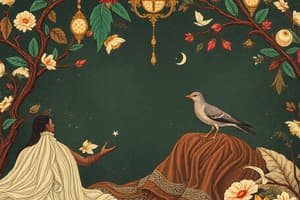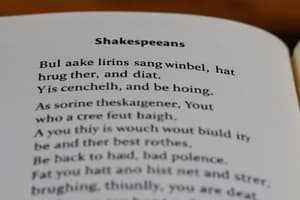Podcast
Questions and Answers
What does 'marriage of true minds' imply?
What does 'marriage of true minds' imply?
- The importance of societal norms
- A view of marriage as temporary
- Intellectual equality between partners (correct)
- A focus on physical attraction
Love is depicted as an easy journey in the analysis.
Love is depicted as an easy journey in the analysis.
False (B)
What is the significance of 'which alters when alteration finds'?
What is the significance of 'which alters when alteration finds'?
It reflects the idea that love remains consistent but requires adjustments.
What imagery is used to describe true love in the lines 'ever fixed marke' and 'it is the star to every wandering barke'?
What imagery is used to describe true love in the lines 'ever fixed marke' and 'it is the star to every wandering barke'?
Time is presented as a controlling force over love.
Time is presented as a controlling force over love.
What is meant by 'beares it out even to the edge of doom'?
What is meant by 'beares it out even to the edge of doom'?
In the line 'love is not time's fool', love is depicted as independent from __________.
In the line 'love is not time's fool', love is depicted as independent from __________.
What biblical reference is suggested with 'edge of doom'?
What biblical reference is suggested with 'edge of doom'?
Match the terms related to love with their meanings:
Match the terms related to love with their meanings:
Flashcards are hidden until you start studying
Study Notes
Analysis of Sonnet 116
- "Marriage of true minds" suggests equality and intellectual compatibility in a relationship, emphasizing love as a soulful connection beyond physical attraction.
- The phrase reflects a holistic view of marriage, indicating that individuals are intertwined on a deeper level, with loyalty and fidelity as core tenets.
- Repetition of 'm' and 't' creates an eternal rhyme which enhances the unity theme.
- "Admit impediments" signifies that love faces obstacles, portraying a realistic perspective that complements an idealistic notion of love.
- The phrase hints at societal barriers, particularly alluding to issues faced by homosexual relationships during Elizabethan times.
- "Which alters when alteration finds" plays on the dual meaning of 'alter,' indicating that love is consistent yet adaptable, embodying both commitment and flexibility.
- Assonance and polyptoton within the lines suggest a deep, continuous bond between partners, suggesting they are made of the same essence.
- "Ever fixed mark" utilizes celestial imagery, equating love to a guiding star like the North Star, symbolizing constancy and direction amidst life's challenges.
- Love is described as a stabilizing force, providing guidance and reminder of its importance, no matter the circumstances.
- "Love is not time's fool" emphasizes love's independence from time's influence, illustrating it as a timeless, unchanging force amidst life's shifts.
- Time is personified as a powerful adversary in "with his bending sickles compass come," relating to mortality and the inevitable decay that comes with it.
- The line conjures a somber image of death, representing the tension between the endurance of love and the passing of time.
- "Bears it out even to the edge of doom" suggests that true love requires sacrifice and endurance, echoing religious themes of love's ultimate sacrifice similar to Christ's.
- The final couplet presents an imperfect rhyme, reflecting the complexities and challenges of love, asserting that if true love were non-existent, the act of writing itself would be meaningless.
Studying That Suits You
Use AI to generate personalized quizzes and flashcards to suit your learning preferences.




